Physical Address
304 North Cardinal St.
Dorchester Center, MA 02124
Definition: incomplete formation of the embryonic ventral abdominal wall leads to a congenital midline anterior abdominal wall defect around the umbilicus (the umbilical cord inserts at the tip of the defect)
Larger omphaloceles (containing liver tissue): these are due to failure of fusion of the lateral body folds
Smaller omphaloceles (containing bowel only): these are due to the persistence of the physiological herniation of the gut after the 10th week of fetal development
Associated chromosomal abnormalities are common (50%): trisomy 13 and 18
Beckwith–Wiedemann syndrome : omphalocele (exomphalos) + macroglossia + gigantism (the ‘EMG’ syndrome) ▸ visceral abnormalities are seen in up to 70% of cases
Diagnosis: this is made on antenatal ultrasound
Prognosis: this depends upon the associated anomalies
Definition: a small defect in the ventral abdominal wall, classically to the right side of a normally positioned umbilicus ▸ it is thought to be due to a localized intrauterine vascular accident leading to full-thickness necrosis of a portion of the anterior abdominal wall
It typically occurs in the absence of any other anomalies
Antenatal US: bowel loops floating freely in the amniotic fluid with no covering membrane
Exposure to the amniotic fluid damages the bowel and the extruded bowel loops are dilated and thickened (postnatally this can result in a thick, fibrous ‘peel’ covering the bowel loops)
Postnatal complications: necrotizing enterocolitis (NEC) in up to 20% ▸ respiratory embarrassment following repair of the defect ▸ short bowel syndrome and intestinal dysmotility ▸ intestinal atresias and stenoses (secondary to the prenatal ischaemic insult)
The associated morbidity and mortality is mainly due to the associated GI problems (gastro-oesophageal reflux ▸ malrotation ▸ small bowel dilatation)
A markedly prolonged transit time (which can be >2 days) is compounded by the requirement for TPN (cholestatic liver disease is a major problem)
Approximately ![]() of males have cryptorchidism, which may result in the testes passing through the defect
of males have cryptorchidism, which may result in the testes passing through the defect
Definition: a rare midline infra-umbilical defect that arises due to an abnormality of the caudal body fold (M>F):
Also known as OEIS complex (omphalocele/exstrophy/imperforate anus/spinal abnormalities) –representing different parts of the same spectrum
Mild: epispadias (urethral meatus opening on the penile dorsum) ▸ a cleft urethra in females
Moderate: bladder exstrophy: the bladder is exposed on the lower abdominal wall
Severe: cloacal exstrophy: abnormalities of the GU and GI tracts, CNS and MSK systems ▸ the cloaca opens onto the lower abdominal wall (open caecum and prolapsing terminal ileum between 2 hemi-bladders) ▸ omphalocele of varying size ▸ blind-ending short gut ▸ ambiguous external genitalia ▸ bilateral inguinal herniae ▸ spinal dysraphism (‘open book’ pelvis) ▸ renal/lower limb abnormalities
AXR: the pubic bones are separated by >25 mm
USS: antenatally the ‘elephant's trunk’ sign of the prolapsed terminal ileum is pathognomonic
Upper GI contrast study: this can detect the presence of malrotation and also outlines the length of bowel present
MRI: this can exclude an associated cord anomaly and delineate the pelvic organs and the pelvic floor musculature
Treatment: the bladder and bowel are separated and repaired, with the abdominal wall defect closed
Definition: a non-hereditary disorder consisting of:
A congenital absence of the abdominal wall muscles : giving a wrinkled and lax abdominal wall
Urinary tract abnormalities : renal dysplasia + gross pelvicalyceal and ureteric dilatation
Cryptorchidism: the bladder distension interferes with testicular descent
AXR: a protuberant abdomen (resulting from the lack of abdominal musculature)
US/micturating cystourethrogram: there are small kidneys with abnormal minimally dilated calyces and upper ureters – the lower ureters are tortuous and show disproportionate dilatation ▸ the bladder is thin walled, of a large capacity (without trabeculation) and has a wide neck ▸ there may be a patent urachus or a urachal diverticulum ▸ the posterior urethra is dilated proximally with typical conical narrowing (± dilatation of the anterior urethra)
MCUG: this is valuable for assessing the urethral anatomy but is dangerous if sepsis arises ▸ vesico-ureteral reflux is seen in ![]() of patients
of patients
IVU: this is rarely indicated
99m Tc-DMSA: this assesses the divided renal function
Dynamic renal scintigraphy: this fails to show adequate drainage due to the gross dilatation
Long-term follow-up : US and 99m Tc-DMSA
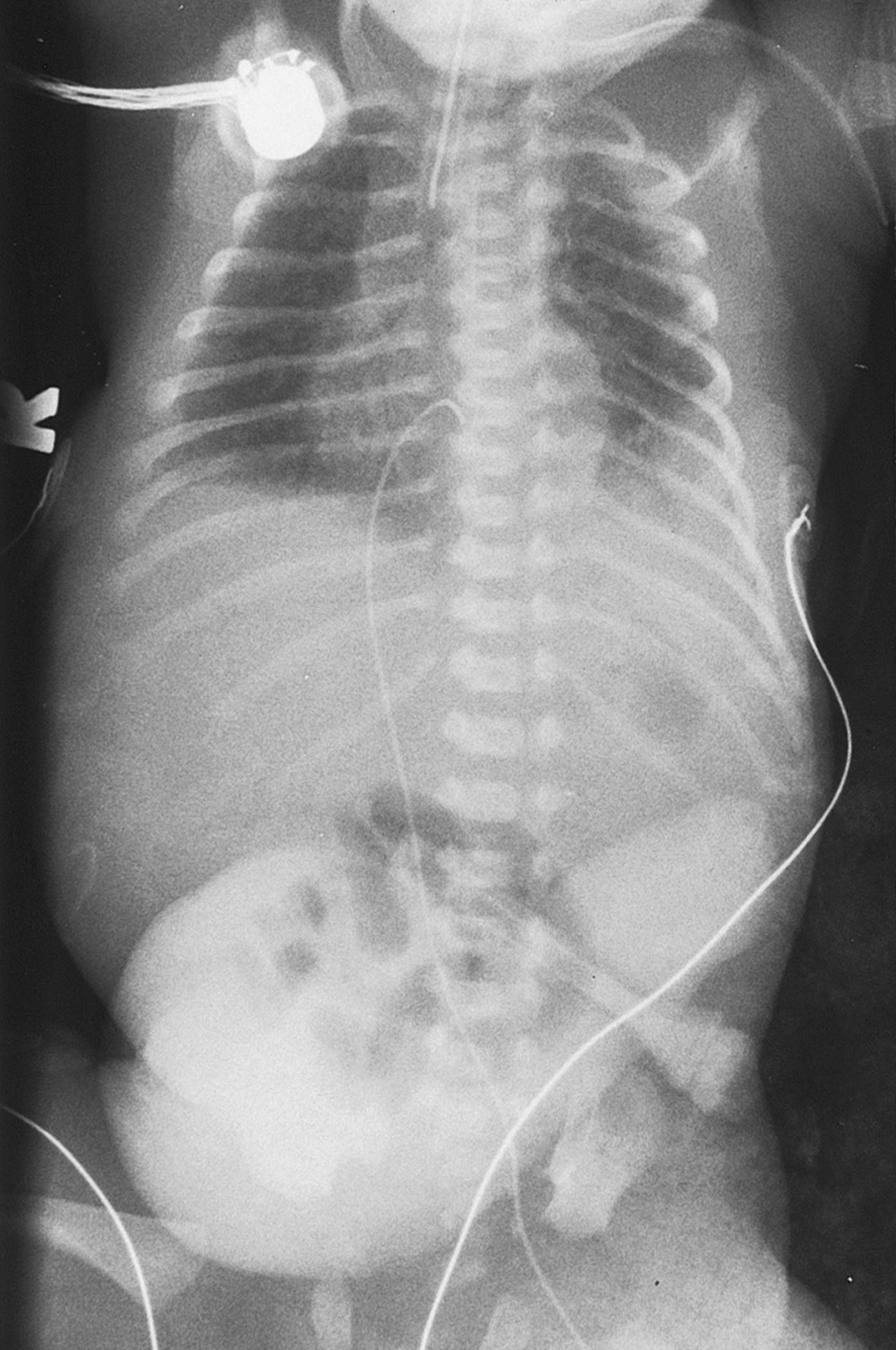
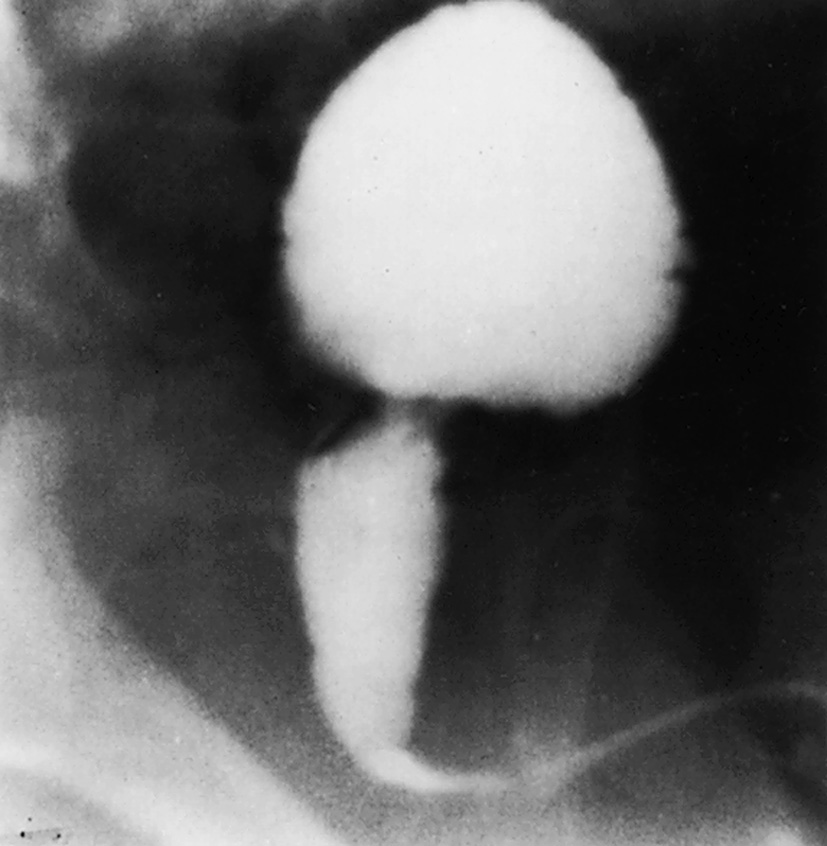
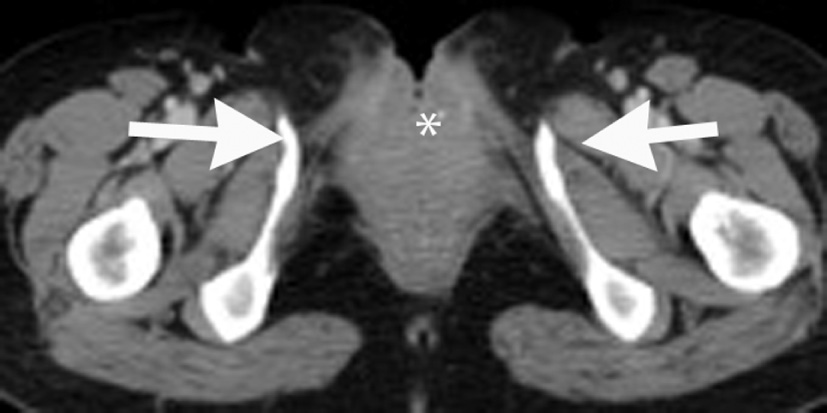
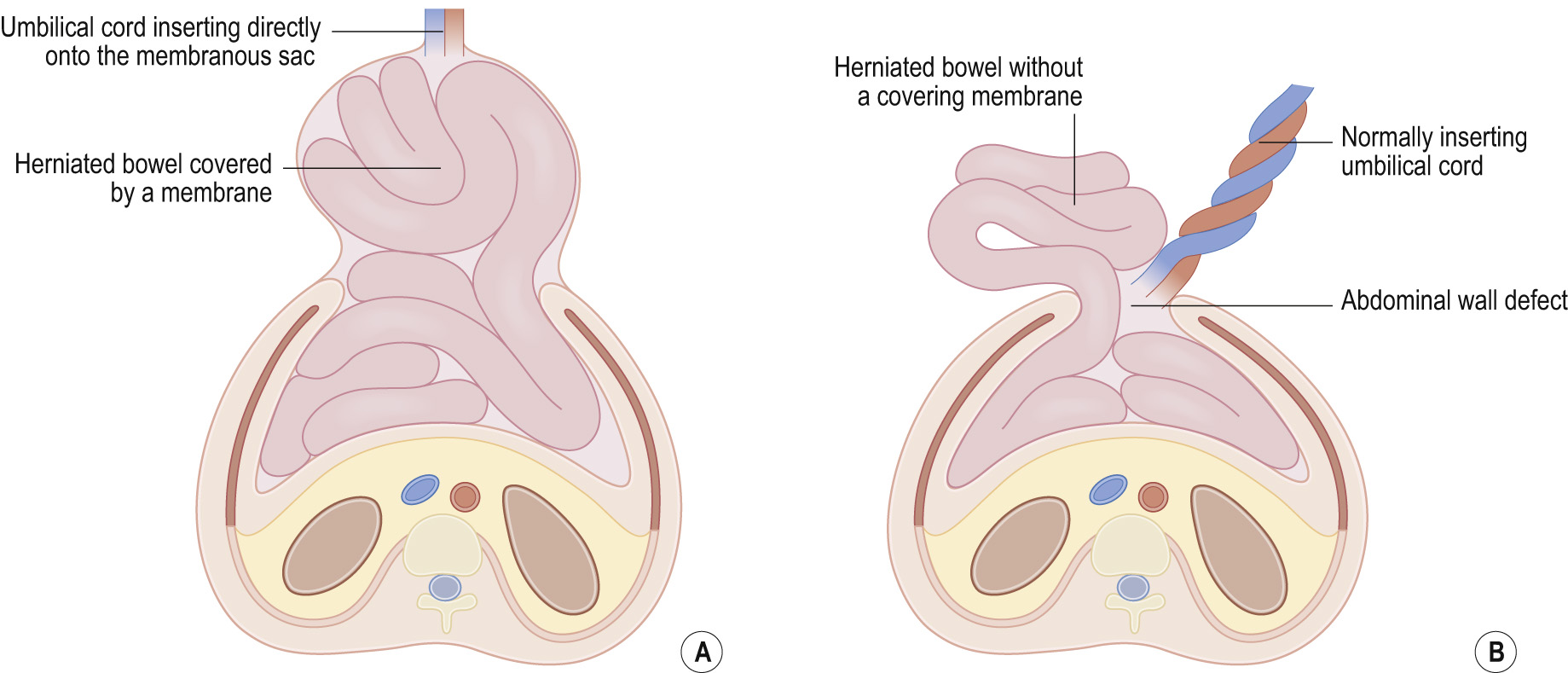
Neonatal non-bilious vomiting due to a GI cause implies the presence of a lesion proximal to the ampulla of Vater and is most frequently due to GOR
Congenital gastric obstruction is rare and is usually due to a web or diaphragm within the antrum and pylorus ▸ occasionally a true atresia is present with a fibrous cord uniting the two blind ends
Other causes: enteric duplication cysts ▸ microgastria
Maternal polyhydramnios ▸ a large fetal gastric bubble
With complete obstruction there will be a dilated stomach with no distal air
Vigorous gastric peristalsis and consistent filling defects within the antrum or pylorus at the site of the web
‘Pseudo-double bubble’ sign: this is seen as barium outlines first the space between the antrum and pylorus, and then the duodenal bulb
Persistent linear, echogenic structures arising from the antral or pyloric walls and extending centrally
An obstruction distal to the ampulla of Vater – malrotation and a midgut volvulus constitute the greatest emergency
Other causes: duodenal atresia and stenosis ▸ duodenal webs and diaphragms ▸ extrinsic duodenal compression (e.g. an annular pancreas or a preduodenal portal vein) ▸ small bowel atresia ▸ small bowel stenosis ▸ sepsis ▸ gastroenteritis
If the AXR demonstrates a complete high intestinal obstruction then no further imaging is required (operative intervention irrespective of the cause) ▸ if the AXR shows a low intestinal obstruction (i.e. distal to the mid ileum) then a contrast enema is preferred
This is caused by failure of recanalization of the duodenal lumen after the 6 th week of fetal life (duodenal atresia is much more common than a duodenal stenosis) ▸ in 80% of cases the level of obstruction is just distal to the ampulla of Vater ▸ obstruction can also be caused by webs and diaphragms or an annular pancreas
Associated anomalies occur in the majority of patients: Down's syndrome (30%) ▸ malrotation (20–30%) ▸ congenital heart disease (20%) ▸ components of the VACTERL association may also be present
Infants present early with bilious vomiting and upper abdominal distension (a preampullary obstruction presents with non-bilious vomiting)
A dilated stomach and duodenal cap ▸ maternal polyhydramnios
A gas-filled ‘double bubble’ of the stomach and duodenal cap ▸ distal gas will be present if the obstruction is partial (or rarely if there is a bifid pancreatic duct straddling the atretic segment)
A duodenal stenosis is seen as a narrowed area within the 2 nd part of the duodenum ▸ a duodenal web may be seen as a thin, filling defect extending across the duodenal lumen
‘Duodenal dimple’ sign: the pressure exerted by a NGT on the obstructing web can cause in-drawing of the duodenal wall at the site of the web's attachment
These follow an intrauterine vascular insult (the vascular insult may be a primary or secondary event such as an antenatal volvulus or intussusception) ▸ an atresia is more common than a stenosis ▸ the proximal jejunum and distal ileum are the most frequently affected segments
The majority of infants present with bilious vomiting in the immediate postnatal period ▸ abdominal distension is seen with more distal atresias
Dilated loops of small bowel are seen down to the level of the atresia (the loop of bowel immediately proximal to the atresia may be disproportionately dilated and have a bulbous contour) ▸ bubbles of distal gas are seen with a stenosis (cf. an atresia) ▸ fine intraluminal calcifications may be seen with a more distal atresia ▸ a meconium peritonitis (with calcification of the peritoneum) may be seen if an intrauterine perforation has occurred
‘Apple peel’ syndrome: this is thought to follow an intrauterine occlusion of the distal SMA ▸ there is a proximal jejunal atresia, with agenesis of the mesentery and absence of the mid small bowel ▸ the distal ileum spirals around its narrow vascular pedicle (giving the syndrome its name) ▸ a malrotated microcolon is also usually present
Medical causes of bilious vomiting include functional immaturity of the colon and gastroenteritis
| Oesophagus |
|
| Stomach |
|
| Duodenum |
|
| Small bowel |
|
| Large bowel |
|
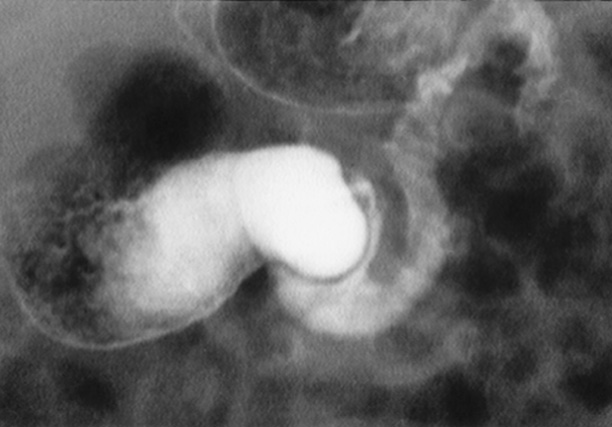
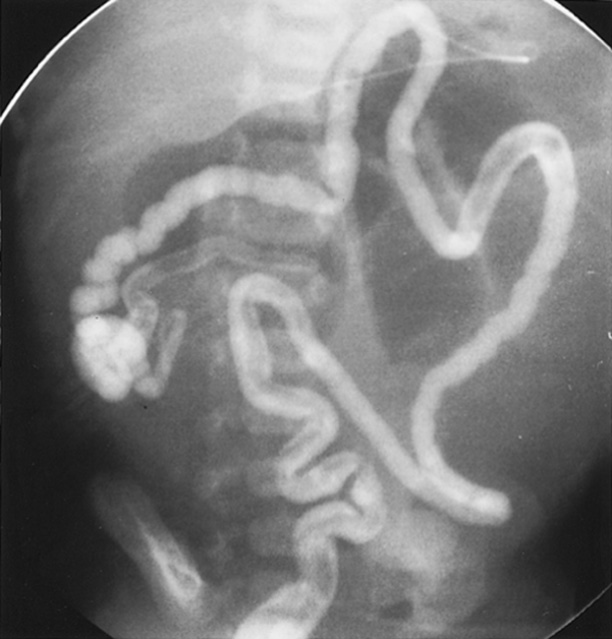
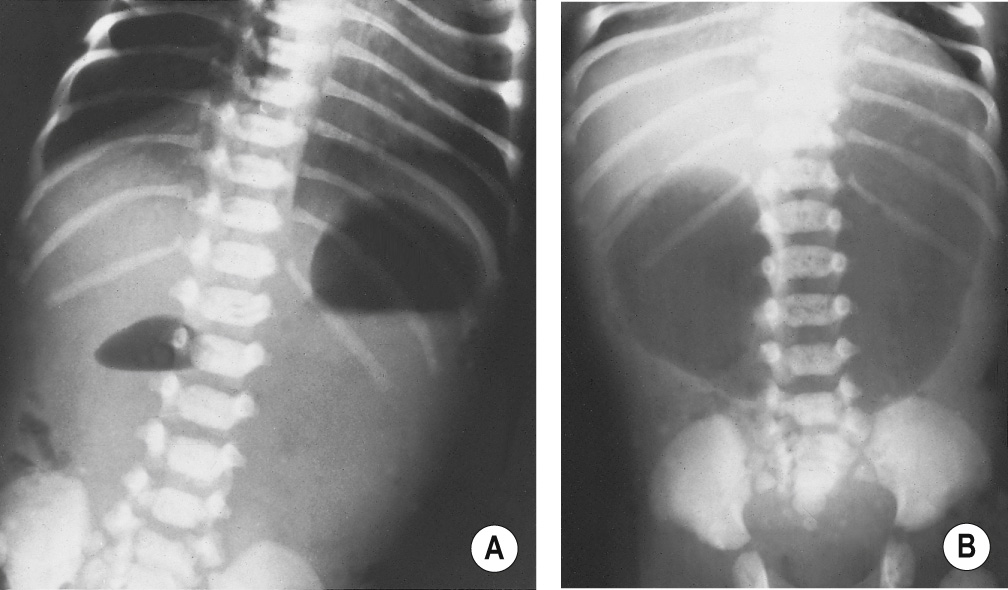
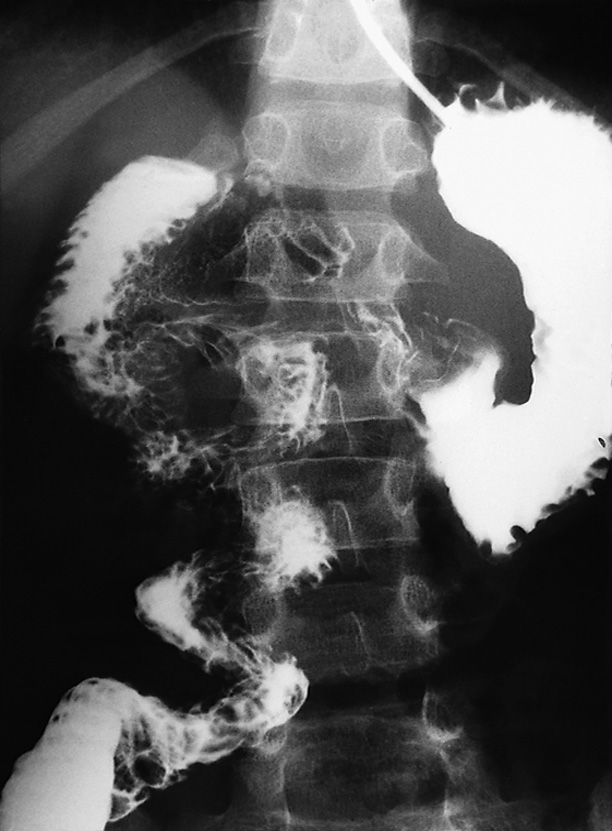
This is due to abnormal partitioning of the laryngotracheal tube from the oesophagus by the tracheo-oesophageal septum during the 4 th week of gestation ▸ it affects 1:3000–4500 live births
The atretic segment of the oesophagus tends to be at the junction of its proximal and middle thirds
A TOF (if present) is usually found proximal to the carina
Occasionally an isolated TOF can occur without an oesophageal atresia (the ‘H’- or ‘N’-type fistula)
50% of patients have associated congenital anomalies:
VACTERL spectrum: V ertebral anomalies ▸ an A norectal malformation ▸ C ardiovascular malformations (VSD, PDA, right aortic arch) ▸ T racheal anomalies ▸ an o E sophageal fistula ▸ R enal anomalies ▸ L imb anomalies
Other anomalies: duodenal atresia and stenosis ▸ an imperforate anus ▸ trisomy 18 and 21 ▸ Potter's syndrome
Antenatal (US): maternal polyhydramnios
Postnatal: an immediate presentation with choking, coughing, cyanosis and drooling (this is exacerbated during attempts to feed)
H-type fistulas generally present later in infancy or childhood with episodes of choking or apnoea during feeding, or recurrent respiratory tract infections
An orogastric tube will curl up within the proximal oesophageal pouch (there can also be aspiration pneumonitis, vertebral anomalies or an abnormal cardiac silhouette)
Gas within the abdomen implies a distal fistula (neonates with a H-type fistula commonly have a abdomen distended with gas)
A gasless abdomen implies an isolated oesophageal atresia (or an atresia with a proximal fistula) ▸ there is an absent fetal gastric bubble if there is an oesophageal atresia (but no TOF)
Isolated oesophageal atresia: a long gap between the atretic segments is seen in association with 13 pairs of ribs
This can delineate an H-type fistula: the patient is placed prone and a horizontal X-ray is used ▸ contrast medium is injected under pressure (via a nasogastric tube with its tip in the distal oesophagus) and the tube is then slowly withdrawn under fluoroscopic guidance (‘withdrawal oesophagram’)
The majority of these fistulas are seen at the level of the thoracic inlet
The gap between the oesophageal pouches can be assessed following the formation of a feeding gastrostomy: under fluoroscopic guidance, a Heger dilator is inserted through the gastrostomy and retrogradely into the distal oesophagus ▸ a Repogle tube is simultaneously used to delineate the superior pouch ▸ as both tubes are radio-opaque, the degree of separation can be easily assessed
Alternatively CT can delineate the gap following the simultaneous injection of air into the upper pouch (via the Repogle tube) and via the gastrostomy
The mortality rates are now no longer due to the oesophageal atresia itself, but due to the associated malformations
A combined bronchoscopy and oesophagoscopy should be performed if there is a high clinical index of suspicion of an H-type fistula with negative imaging
Recurrent TOF (10%): this should be suspected if the oesophagus is gas filled on CXR and if contrast medium studies show ‘beaking’ of the anterior oesophageal wall
Other complications: anastomotic breakdown (10–20%) ▸ anastomotic strictures (up to 80%, more likely in long gap OA) ▸ disordered oesophageal and distal GI motility ▸ gastro-oesophageal reflux
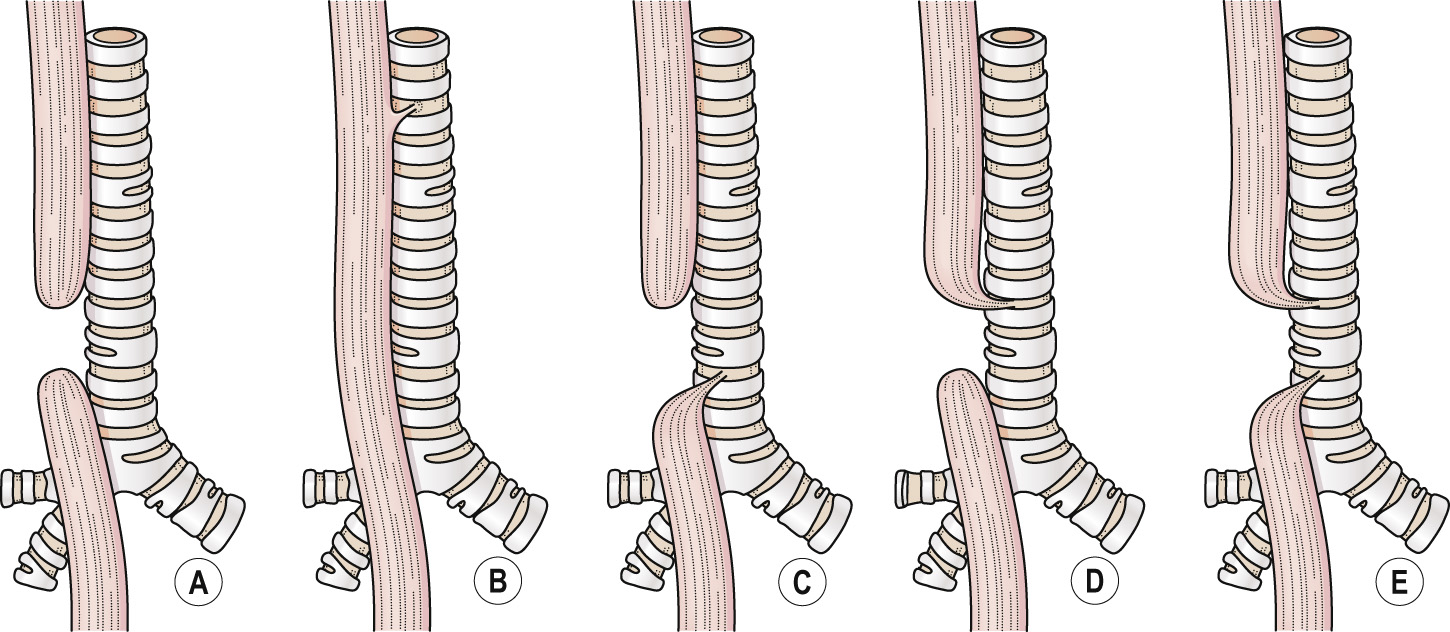
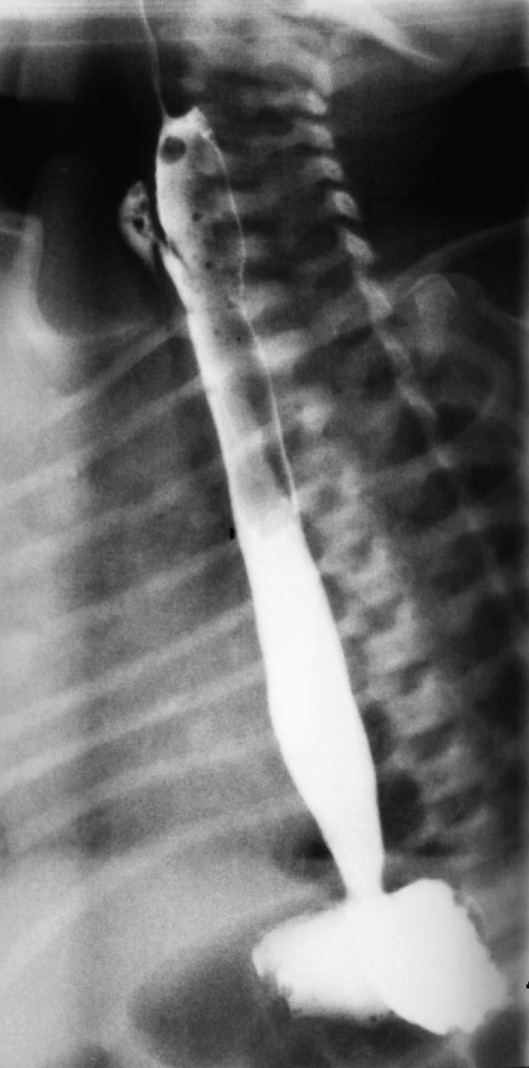
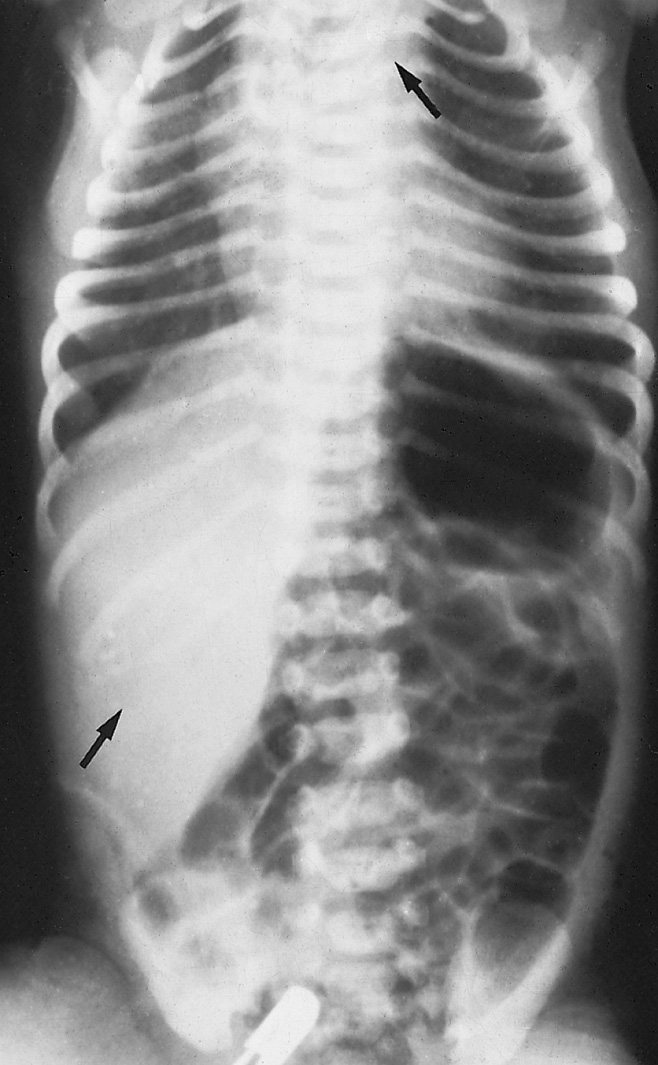
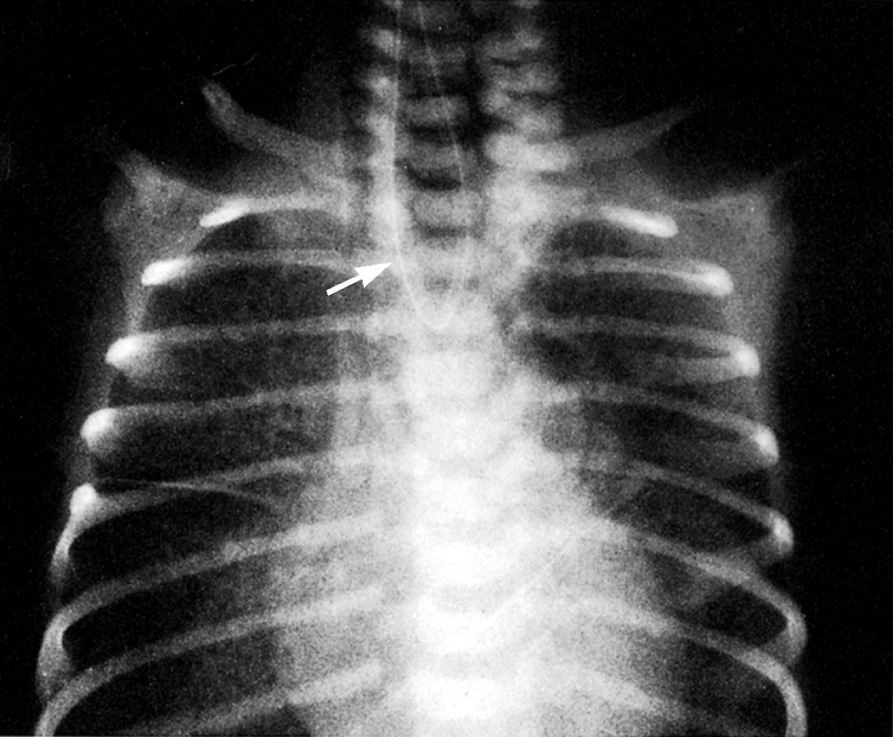

Malrotation is a generic term used to describe any variation in the intestinal position ▸ intestinal malfixation invariably accompanies malrotation in an attempt to fix the gut in place
Peritoneal (Ladd) bands: these stretch from the abnormally high-lying caecum, across the duodenum and to the region of the porta hepatis and the anterior and posterior abdominal walls ▸ Ladd bands can cause duodenal obstruction
The abnormal positions of the duodenojejunal junction and caecum means that the base of the small bowel mesentery is short
Midgut volvulus: the midgut has a propensity to twist around this narrow base compromising its vascular supply – this can lead to ischaemic necrosis of the small bowel with an associated high mortality rate if undiagnosed
This commonly presents within the 1 st month of life with bilious vomiting ▸ older children may present with non-specific symptoms of chronic or intermittent abdominal pain, non-bilious emesis, diarrhoea, or a failure to thrive
Symptoms of shock intervene if bowel ischaemia and necrosis have developed
There are no specific features – it may be normal if a volvulus is intermittent or if there is incomplete duodenal obstruction due to loose twisting of the bowel
A tight volvulus results in complete duodenal obstruction with a distended stomach and proximal duodenum (mimicking the ‘double bubble’ of duodenal atresia)
Closed loop obstruction: this is a more ominous sign and is associated with distal small bowel obstruction ▸ the volvulus causes venous obstruction and small bowel necrosis – the small bowel loops will be thickened and oedematous (± pneumatosis) and any gas cannot be reabsorbed from the bowel lumen
A gasless abdomen can be seen with prolonged vomiting, a closed loop obstruction with viable small bowel, or with a massive midgut necrosis
Normal: on a supine AXR the normal duodenojejunal junction lies to the left of the left-sided pedicles at the height of the duodenal bulb ▸ on a lateral view, the junction of the 2 nd and 3 rd parts of the duodenum is retroperitoneal
Malrotation: the duodenojejunal junction is displaced inferiorly and to the right on a supine AXR ▸ the junction of the 2 nd and 3 rd parts of the duodenum turns sharply anterior ▸ the distal jejunal loops lie to the right of the midline ▸ the caecal pole may lie high and more to the left side
‘Corkscrew’ pattern: this describes the duodenum and jejunum spiralling around the mesenteric vessels and is pathognomonic for a midgut volvulus
If Ladd bands are causing the duodenal obstruction rather than a volvulus the duodenojejunal course has been described as ‘Z-shaped’ rather than spiral
Become a Clinical Tree membership for Full access and enjoy Unlimited articles
If you are a member. Log in here